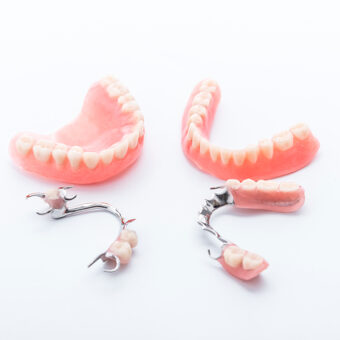One of the ways to replace missing teeth to restore oral function and appearance is with dentures. Depending upon the needs of a case, dentures can be used to replace either a few teeth that have been lost or all of the teeth in the upper or lower jaws. In addition to reestablishing the look of a complete and natural smile, dentures also restore support to the natural contours of the face to eliminate the “sunken” appearance that results from losing multiple teeth. Whether teeth have been lost for reasons of tooth decay, gum disease, a medical condition, congenital anomaly, or trauma, dentures are an effective method of care.
Dentures are removable appliances that are designed to precisely and comfortably rest on top of the gums that cover the jawbones. They can be taken out of the mouth for brief periods of time to fulfill the oral hygiene requirements of maintaining the underlying tissues, cleaning the dentures, and sleeping.
Types of Dentures
The two main types of dentures are: full dentures and partial dentures. Both types are custom fabricated based on the exact specifications obtained from dental impressions and detailed functional as well as esthetic information provided by the dentist.
Full Dentures
Full dentures, which can also be referred to as, “complete Dentures,” are designed to replace all of the upper or lower teeth. A complete maxillary denture, more commonly known as a, full upper denture, typically consists of a base that covers the roof of the mouth with a full complement of artificial teeth set around the section covering the dental arch. On the other hand, a complete mandibular denture, or full lower denture, is designed to accommodate the tongue and is horseshoe shaped with teeth set along the portion that covers the underlying dental arch.
- Conventional Full Denture – A conventional full denture is fabricated and placed after all of the remaining teeth have been removed and the tissue is healed. It takes several weeks for extraction sites to heal and for all of the surrounding bone and gum tissues to fill in and remodel. By allowing this process to reach completion before taking the final impressions for a new denture, the most precise and comfortable fitting prosthesis can be fabricated.
- Immediate Denture – An immediate denture is one that is inserted on the day the remaining teeth are removed. With this method of care, a patient does not have to be without teeth while waiting for complete healing of the extraction sites. Immediate dentures offer the distinct cosmetic advantage of not having to be without teeth. However, since the healing of the extraction sites is occurring while wearing the denture, a reline or new denture may be required later for improved comfort and fit.
- Overdenture – An overdenture is a type of complete denture that receives added stability and support from special attachments that are secured to the remaining underlying teeth or strategically placed dental implants.
Partial Dentures
A partial denture is a type of removable prosthesis that is designed to restore a complete and functional smile in cases where multiple teeth are missing or require extractions, while some healthy teeth remain in the dental arch. Custom fabricated for a precise fit and cosmetically pleasing appearance, partial dentures are typically secured and stabilized with clasps or precision attachments to select teeth adjacent to the edentulous areas. Depending upon the number of teeth being replaced as well as the functional and aesthetic requirements of the case, a partial denture can be fabricated from a combination of cast metal and acrylic materials, acrylic alone, or thermoplastic resins such as ValplastTM, Flexite®, Duroflex® and tcs®.

